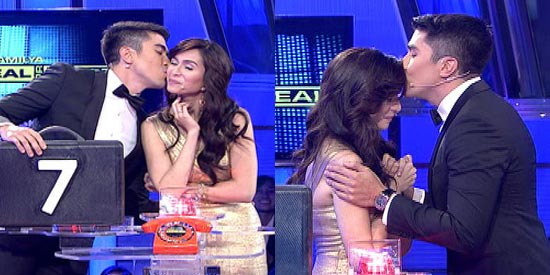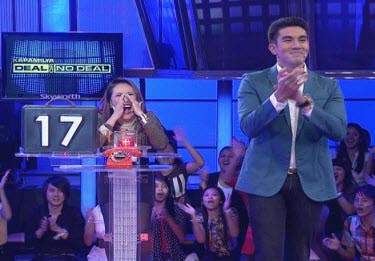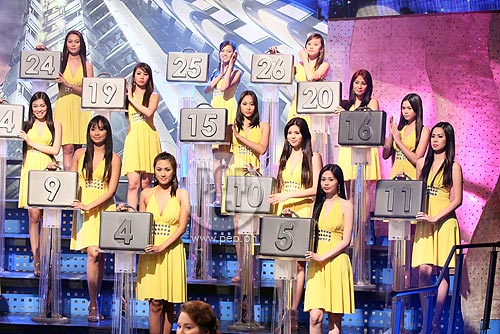
-
МјРЇСІИёСЖШИМі
-
 MINUTE TO WIN IT
MINUTE TO WIN IT 46,698
46,698 -
 Apple Eating Contest Game
Apple Eating Contest Game 34,164
34,164 -
 SINGING BEE
SINGING BEE 23,646
23,646 -
 DEAL OR NO DEAL23,226
DEAL OR NO DEAL23,226 -
 rodeo masbatenio19,386
rodeo masbatenio19,386 -
 Luksong Lubid14,173
Luksong Lubid14,173 -
 Tumbang Preso12,116
Tumbang Preso12,116 -
 HULA HOOP12,090
HULA HOOP12,090 -
 EGG AND SPOON RACE12,082
EGG AND SPOON RACE12,082 -
 BUNONG BRASO ( ARM WRESTLING)12,009
BUNONG BRASO ( ARM WRESTLING)12,009
DEAL OR NO DEAL
One of the countryЁЏs most sought after and premiere hosts,
Luis Manzano takes on Kapamilya Deal or No Deal after three
successful seasons hosted by Queen of All Media Kris Aquino.
Among the things to watch out for is the new Banker who
would offer tempting deals to the studio player. New briefcase
girls, now called 24K girls, will also do the iconic ЁЎrampaЁЏ
and hold the amounts that will change the course of the game.
A whopping P2 million jackpot prize is still at stake if the contestant chose
the winning briefcase.
The smallest prize has always been ₱1 (about 2¢ (US), Ђц0.01, 1p, and ¥2), but
the grand prize has always varied, from ₱2,000,000 (about US$47,000,
Ђц31,000, £21,000, and ¥5,000,000), to ₱4,000,000 (about US$94,000, Ђц62,000,
£42,000, and ¥10,000,000) for a short period, to ₱3,000,000 for the second
season, and back to P2,000,000 for the third season. The game show's tagline is
"Ang Kapalaran mo, Desisyon Mo" which in turn translates in English as
"Your Fate, [is] Your Decision." At the time of its premiere, this was the first
weekday primetime game show in the Philippines since the so-called
primetime game show craze died down in late 2002, with Pilipinas, Game KNB?,
the last remaining show among the weekday primetime game shows,
reformatted into a daytime one after a relatively brief hiatus (although it had
a primetime spinoff called Pasko Na, Game KNB? for three weeks on
December 2005 to January 2006).
Gameplay
The Philippine version is very similar to the U.S. version of Deal or No Deal (including the logo),
except for the sounds and musical scoring which were adapted from the Dutch version.
Before the game proper begins, a third party randomly places the possible amount of prize
in the briefcases, which are distributed to 26 identically dressed models called the 26K
who reveal the contents during the game. No one, including the host, knows what amounts
are in the cases. Each contestant receives a new, randomly assigned set of cases. The prizes
range in amounts from PHP1 to PHP2,000,000. See listing below.
After picking a case, the contestant then selects six of the remaining 25 cases, revealed
one at a time. This is followed by a "phone call" by "The Banker", a mysterious figure whose
face is not shown (at times a silhouette can be seen). He purportedly sits in a skybox
(situated between the two audience sections) and makes an offer, via telephone to the
host (his voice is never heard) to buy the contestant's case based on the mean of the
cash amounts still in play, and also based on the player's psychology. This amount is usually
lower than the mean. In more recent episodes, the banker "punishes" a player of opening a
large amount by offering a very small amount, despite the number of larger amounts still
left in play. The player is then asked by Kris the title question: "Deal or No Deal?"
Should the contestant refuse the offer (by stating "No Deal!"), they must choose five of the
remaining cases to eliminate from consideration. The Banker makes another offer, and the
game continues as before. The Banker's offer may be higher or lower than the previous offer
(if a top prize is eliminated, generally the offer decreases; conversely, if lower amounts are
eliminated the offer increases significantly).
The contestant is shown a button to press in case the contestant takes the banker's offer.
The player can just push the button to take the offer, even without saying "Deal." On the other
hand, the contestant can simply close the button's cover to imply "No Deal" without actually
saying the phrase.
Subsequent rounds have the contestant withdrawing five, four, three, then two cases from
play, with Banker's offer appearing in between rounds; should the contestant continue to
decline The Banker's offer after the two cases were picked, he/she then eliminates one
case at a time (with an intervening offer from The Banker) until two cases are left. If the
player rejects the final offer, they receive whatever cash amount is contained inside the
case that they originally chose.
Each contestant has several supporters (usually three or four), who sit in a special section
just off stage during his/her game. As the field of briefcases dwindles, one or more of the
supporters are asked to consult with the contestant and help him/her make a decision.
These exchanges have become emotional, particularly when very high and very small
amounts remained and The Banker offers a large cash buyout. The contestant's supporters
are typically revealed after the second Bank deal and before the third round; although if a
contestant is doing well, the host will let the game run its course for some time, often
consulting the supporters when the tide begins to turn.
If in case the contestant decides to accept the offer of the Banker at the end of any round,
the host will let him go on ("No Deal" instead of "Deal" assumed at that point) until the end
(at the end of every subsequent round, the amount offered by the Banker is revealed to him
and "No Deal" is assumed) to determine if he made the correct decision.
In the fourth season (2012), due to the reduced number of briefcases from 26 to 24, the
number of briefcases opened in each round is also modified, starting from five in the first
round, three in each of the next three rounds, two in each the next three rounds, and one in
each the final two rounds. Gameplay otherwise remains the same, with the exception of a
routine option to swap briefcases in the end. The offer to swap briefcases was only given
one time during Aquino's tenure.
Contestants, who joined through text messaging, are selected and screened with a series
of interviews and tests, including a psychological one, before they appear on the show.

- ЁЄ
- ЁЄ
- ЁЄSalapan Festival
- ЁЄEmpanada Festival (Batac City)
- ЁЄPADUL-ONG FESTIVAL
- ЁЄKaumahan Festival in Barili
- ЁЄKAGASANGAN FESTIVAL
- ЁЄLalin Festival in Asturias
- ЁЄTinabuay Festival
- ЁЄGayon Bicol Festival
- ЁЄPINYASAN FESTIVAL in CAMARINES
- ЁЄMAGAYON FESTIVAL
- ЁЄBANAUAN FESTIVAL (BARANGAY.GUA
- ЁЄThe Tuna Festival in Gensan
- ЁЄPINTOS FESTIVAL BOGO CITY, CEB



- ЁЄ
- ЁЄ
- ЁЄ
- ЁЄCEBU WESTOWN LAGOON
- ЁЄGREEN LAGOON, COMPOSTELA
- ЁЄCALLAO CAVE
- ЁЄMOUNT PINATUBO IN PHILIPPINES
- ЁЄBATAN ISLAND in Batanes.
- ЁЄCALAGUAS ISLAND, CAMARINES NOR
- ЁЄAGHO ISLAND
- ЁЄCARAMOAN ISLAND IN CAMARINES S
- ЁЄSAMBAWAN ISLAND
- ЁЄPLACES TO VISIT IN LANAO DEL N
- ЁЄPLACES TO VISIT IN ZAMBOANGA C
- ЁЄPlaces to visit in Rizal Provi













 ЧЪРкДхФФ ОпАЃЛѓДу ПРЧТ
ЧЪРкДхФФ ОпАЃЛѓДу ПРЧТ 12ГтПЌМг МвКёРкИИСЗ 1РЇ
12ГтПЌМг МвКёРкИИСЗ 1РЇ
 ГЛАд ИТДТ ОюЧаПј УЃБт
ГЛАд ИТДТ ОюЧаПј УЃБт
 ИЎОѓ ЧаБГ ЙцЙЎБт
ИЎОѓ ЧаБГ ЙцЙЎБт
 СжИЛПЁ ГЛАЁ ОЕ КёПыРК?
СжИЛПЁ ГЛАЁ ОЕ КёПыРК? УжАэАЁМККё РЬКЅЦЎ СёБтБт
УжАэАЁМККё РЬКЅЦЎ СёБтБт
 ЧіСіПЁМЕЕ ЧЪРкДхФФ!
ЧіСіПЁМЕЕ ЧЪРкДхФФ! ЧіСіПЁМ АЁДЩЧб
ЧіСіПЁМ АЁДЩЧб









 ЧЪРк ЦЏБо Ч§ХУ! ФСНУОюСі МКёНК
ЧЪРк ЦЏБо Ч§ХУ! ФСНУОюСі МКёНК









































